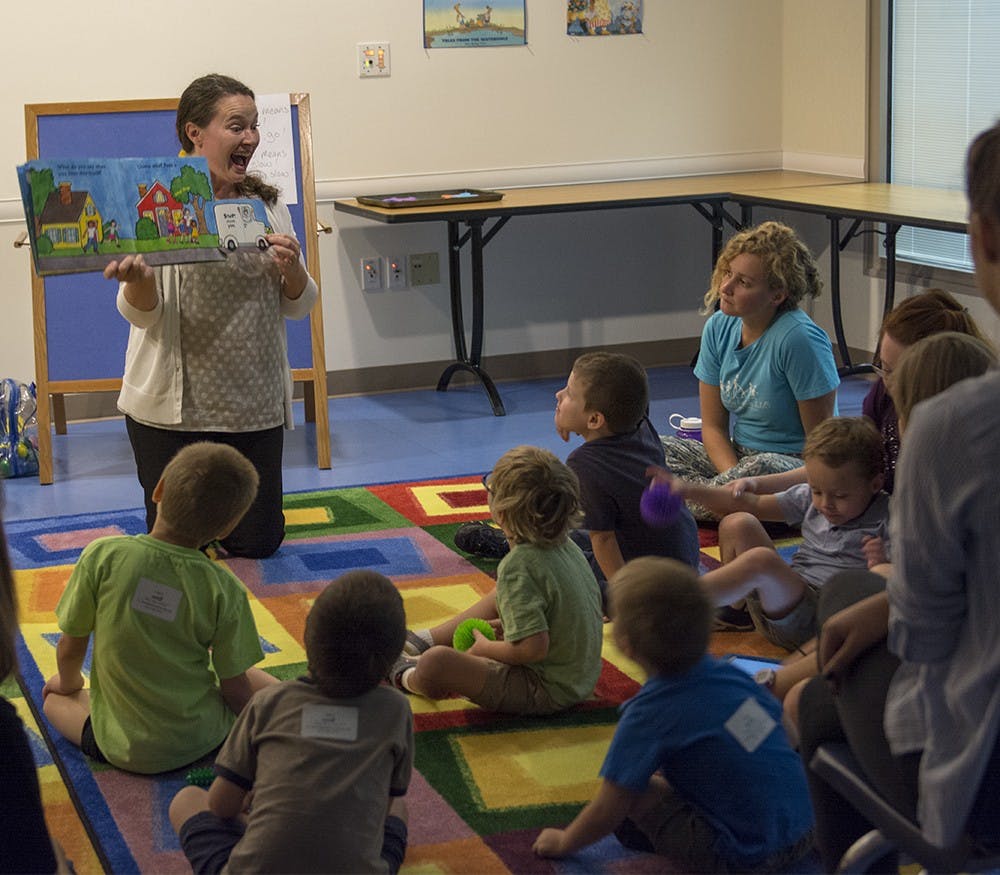“Here come the bubbles!” said the 43-year-old Monroe County Library’s children’s services librarian. “One, two, three!”
Below her, three of the six preschool boys who had arrived for the start of Sensory Storytime — created specifically for children on the autism spectrum or with sensory integration issues — jumped and grabbed at the bubbles, darting around on a multicolored rug.
Posters adorned the walls of the room, advertising books ranging from “The Happy Hedgehog” to Henry David Thoreau’s “Walden.”
At the front end of the room, a pair of boards was set up to help Jones maintain order. One resembled a traffic light, while the other was an itinerary of the session’s activities.
Knowing when they’ll reach certain events, such as playtime, helps children on the autism spectrum focus, Jones said.
For Sensory Storytime, the room was mainly dark.
Only three of the room’s overhead lights — none of them fluorescent — shone, all at the front of the room, above Jones.
Tables had been pushed to the walls, and toys were mostly hidden or put away, save for a few in the “quiet corner,” where overwhelmed children can go to calm down.
External stimuli like lights and toys can be distracting, Jones said.
***
Mary Frasier, a children’s services librarian who helped develop the program last summer, said the program is the result of a combination of a disabilities-focused library subcommittee, a class through the Association of Specialized and Cooperative Library Agencies and work with the Indiana Institute on Disability and Community.
“It was an outgrowth of this overall increase in sensitivity and gaining knowledge of how to better serve people with disabilities,” she said.
In December 2014, Sensory Storytime won the library an Indiana Library Federation programming award.
“It’s kind of taking what we are already competent at doing, which is storytelling, using music for children and adapting it by, for instance, presenting a book and then finding a way to tell that book so that we’re repeating material kind of in two different modes,” Frasier said.
Jones said the program’s introduction was a step-up for the library’s disability services.
“We’ve always accommodated and served people with disabilities happily, but we knew there could always be more,” Jones said.
Jones has been at the library for 14 years, though she previously earned a master’s degree in education.
Her time involved in special education while working toward her degree made her interested in programs like Sensory Storytime that benefit children with disabilities, she said. She added that connecting with a child who usually has trouble connecting or communicating is especially rewarding.
“I love the looks on their faces, the feedback, the laughing, the clapping along, the wondering aloud what’s going to happen,” she said.
***
After putting away the bubble-maker, Jones began to sing.
During this part of the Storytime, which Jones called “Fingerplay,” three more preschoolers, accompanied by adults, came in.
The children picked colored figures from a basket Jones passed around and settled in, and Jones started on the first book of the session, an illustrated run-down of various vehicles and onomatopoeia such as “toot-toot” for a tugboat or “ping-ping” for a submarine.
After a brief interlude involving colorful egg shakers and the faux stoplight — green means shake fast, red means stop shaking — Jones continued with the stories.
After the story, Jones handed out yellow strips of latex called Thera-Bands. The bands are marketed as exercise tools, but the kids stretched, tossed and flapped the bands, making noise as they did.
Jones began singing “Row, Row, Row Your Boat,” and the noise stopped as the children sang along.
For the last activity, Jones replaced the traffic light with a cut-out of a purple, skateboard-riding cat named Pete. Her story about Pete the Cat combined the singing, storytelling and interaction of the rest of Sensory Storytime.
Before she let the children go for free playtime, Jones encouraged them to join her in singing goodbye. In unison, they clapped their hands, wiggled their fingers and waved.
“Wave, wave, wave goodbye,” they sang. “Wave goodbye together!”
Amanda Satchwill, 25, is a behavior analyst who works with children with disabilities. She has been bringing groups of children to participate in the program since it began.
When bringing children to Storytime, Satchwill said she usually has specific goals in mind for each child. The Storytime sessions have been useful.
“We come here to work on socialization and community skills for the children,” she said.
Frasier said the most satisfying aspect of Storytime is seeing children respond in ways that surprise parents or caregivers.
“The thing that always happens in this program is they’ll say, ‘We can’t believe he was talking,’” she said. “There’s always some sort of breakthrough for one child. It feels like a triumph.”






